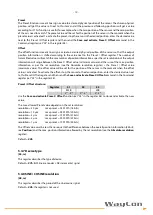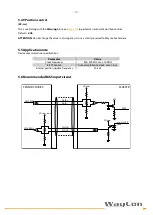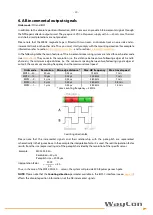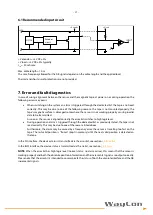
- 8 -
3. Electrical connection
Signal
Pins
Cable colour
Connector output M12, male
GND
1
BK
+V
2
RD
Clock IN + / MA +
3
YE
Clock IN - / MA -
4
BU
Data OUT + / SLO +
5
GN
Data OUT - / SLO -
6
OG
A
1)
7
WH
B
1)
8
GY
Shield
Housing
Shield
1)
incremental signals A and B are only provided in versions SSII and BISS (see order code in the
Cable specifications
Model
HI-FLEX cable
Wires
6 x 0.14 mm² + 2 x 0.22 mm²
Shield
Tinned copper braid
External diameter Ø
5.3...5.6 mm
Conductor resistance
<148 Ω/km (0.14 mm²); <90 Ω/km (0.22 mm²)
Minimum bend radius
Ø x 7.5 mm
3.1 GND connection
Minimize electronic noise by connecting the shield and/or the connector housing and/or the sensor to GND.
Make sure that GND is not affected by electronic noise. The connection point to GND can be situated both on
the device side and/or on user’s side. The best solution to minimize the interference must be carried out by the
user.
4. SSI interface
Order codes:
SSIG, SSII and SSIB
4.1 SSI (Synchronous Serial Interface)
SSI (the acronym for Synchronous Serial Interface) is a synchronous point-to-
point serial interface engineered for unidirectional data transmission between
one Master and one Slave. Developed in 1984, it is based on the RS-422 serial
standard.
Its most peculiar feature is that data transmission is achieved by synchronizing both the Master and the Slave
devices to a common clock signal generated by the controller. In this way the output information is clocked
out at each controller's request. Furthermore, only two pairs of twisted wires are used for data and clock signals,
thus a six-wire cable is required.
The main advantages in comparison with parallel or asynchronous data transmissions are:
•
less conductors are required for transmission
•
less electronic components
•
possibility of insolating the circuits galvanically by means of optocouplers
•
high data transmission frequency
•
hardware interface independent from the resolution of the absolute sensor
Furthermore, the differential transmission increases the noise resistance and decreases the noise emissions. It
allows multiplexing from several sensors and thus process controls are more reliable with simplified line design
and easier data management.
1
2
5
4
3
7
6
8
Содержание MXS2
Страница 1: ...Magnetic Scale MXS2 Manual...























